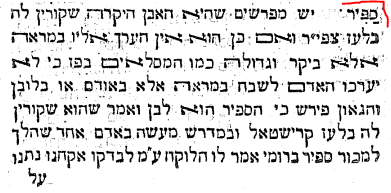In parashat Pekudei we have an enumeration of the stones in the Choshen, such as (Shemot 39):
But this list can be potentially pretty useless since unlike common words like אמר and שמר, these are uncommonly used words in a very narrow domain (gemology). And since the meaning of words shifts over time, we cannot be sure we are speaking of the same item. For instance, many say that Biblical sappir is not sapphire rather lapis lazuli.
So it is not surprising that there is further dispute about the identity of Sappir. According to the quote that follows, Rav Saadia Gaon identified it as crystal while Michlal Yofi, on the basis of a Midrash Eicha Rabbati identified it as diamond.
Thus, from the collected commentary of Saadia Gaon on Torah:

crystal (n.) 
I am not sure where the quote of Saadia Gaon ends and Michlal Yoffi begins.
I also wasn't able to find this quote at all in Michlal Yoffi. Maybe there is another Michlal Yofi by another author, or another edition from the same author? This is what I found on the pasuk on Eicha from R' Shlomo ibn Melech in Michlal Yofi:
Update: Thanks to Yitzchok, in the comment section, who pointed me at two earlier versions, which do have the quote:
I don't know why the later version would have omitted it. (Assuming that the earlier versions are original and don't reflect someone's insertion.) Maybe in the interest of space, since the other two or three opinions, namely Saadia Gaon, the midrash, and Ibn Ezra, are ones found elsewhere?
| יא וְהַטּוּר, הַשֵּׁנִי--נֹפֶךְ סַפִּיר, וְיָהֲלֹם. | 11 And the second row, a carbuncle, a sapphire, and an emerald. |
But this list can be potentially pretty useless since unlike common words like אמר and שמר, these are uncommonly used words in a very narrow domain (gemology). And since the meaning of words shifts over time, we cannot be sure we are speaking of the same item. For instance, many say that Biblical sappir is not sapphire rather lapis lazuli.
So it is not surprising that there is further dispute about the identity of Sappir. According to the quote that follows, Rav Saadia Gaon identified it as crystal while Michlal Yofi, on the basis of a Midrash Eicha Rabbati identified it as diamond.
Thus, from the collected commentary of Saadia Gaon on Torah:

" נֹפֶךְ סַפִּיר -- And the Gaon explained that Sappir was white, and that it is what they called in foreign tongue kristal.
[Josh: To interject:
Old English cristal "clear ice, clear mineral," from Old French cristal (12c., Modern French crystal), from Latin crystallus "crystal, ice," from Greek krystallos, from kryos "frost," from PIE root *kru(s)- "hard, hard outer surface" (see crust). Spelling adopted the Latin form 15c.-17c. The mineral has been so-called since Old English; it was regarded by the ancients as a sort of fossilized ice. As a shortened form of crystal-glass it dates from 1590s. As an adjective, from late 14c.
]
And in the Midrash [Eicha Rabbati , on the pasuk in Eicha 4:7:
ז זַכּוּ נְזִירֶיהָ מִשֶּׁלֶג, צַחוּ מֵחָלָב; אָדְמוּ עֶצֶם מִפְּנִינִים, סַפִּיר גִּזְרָתָם. {ס} 7 Her princes were purer than snow, they were whiter than milk, they were more ruddy in body than rubies, their polishing was as of sapphire; {S}
and specifically on סַפִּיר גִּזְרָתָם -- the sappir is something which is kal [or else kasheh]. Rabbi Pinchas said]
'there was an incident with a certain person who went to sell a sappir in Rome. The purchaser said to him, "I am purchasing it in order to investigate its properties." He placed it upon a sheet and began to strike it with a hammer. The hammer broke and the sappir stayed in its place.'
And according to this Midrash, this is the gem they call the diamond, and it is white and pure, end quote." (Michlal Yoffi citing Rav Saadia Gaon za'l on Eicha)
I am not sure where the quote of Saadia Gaon ends and Michlal Yoffi begins.
I also wasn't able to find this quote at all in Michlal Yoffi. Maybe there is another Michlal Yofi by another author, or another edition from the same author? This is what I found on the pasuk on Eicha from R' Shlomo ibn Melech in Michlal Yofi:
Update: Thanks to Yitzchok, in the comment section, who pointed me at two earlier versions, which do have the quote:
I don't know why the later version would have omitted it. (Assuming that the earlier versions are original and don't reflect someone's insertion.) Maybe in the interest of space, since the other two or three opinions, namely Saadia Gaon, the midrash, and Ibn Ezra, are ones found elsewhere?




8 comments:
I don't trust that collected commentary at all. Sometimes it has quotes from the Rambam or Zohar. I don't know what to make of that.
see מכלל יופי איכה פרשה ג.
yitchok:
thanks, but I still don't see it. which pasuk?
the link / image I gave above from Michlal Yofi WAS from eicha (not from Koheles, as I accidentally initially wrote it), but I don't see anything there. I just scanned through the third perek and don't see any comment about Sappir.
could you please offer further directions. e.g. a link to the sefer, an image of it, a citation of the text?
thanks,
josh
look here on the left side on the bottom:
http://www.hebrewbooks.org/pdfpager.aspx?req=21024&st=&pgnum=99
I see, by mistake I wrote פרק ג, its in פרק ד.
I'm sorry.
also, what we learn from this is, always to check in the earliest edition available.
as you can see in the vilna print, that you linked, the peace is missing.
while you can find it in the Amsterdam print from 1660-1661.
one can also find it in the first edition from 1549:
http://www.hebrewbooks.org/pdfpager.aspx?req=11771&st=&pgnum=63
thanks! fascinating.
i'll try to add this (pictures, etc) to to post.
R' Aryeh Kaplan's attribution to Rav Saadia identifying sapir as diamond is therefore incorrect.
Post a Comment